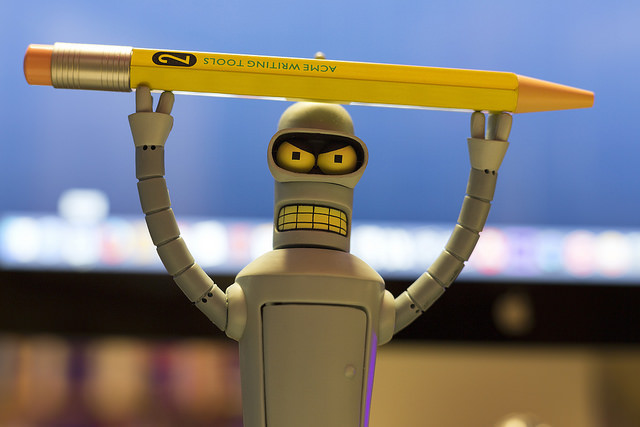
Image source: Delgrosso via Flickr
Artificial intelligence (AI) will soon replace humans in a variety of white-collar jobs, many predict. Robots won’t replace PR writers, at least not in the foreseeable future. Writers face only a 3.8 percent chance of being supplanted by automation, according to a 2015 NPR survey.
AI can already produce straightforward news articles and complete many writing-related functions. Still, AI technology will transform the writing process but almost certainly not replace writers. PR professionals can take advantage of AI and machine learning to automate routine aspects of writing and editing and complete writing tasks faster, leaving more time for more strategic functions.
Artificial intelligence can complete these writing or writing-related tasks:
Translation
An upgrade of Google Translate in 2016 greatly improved its language translation capabilities. Previously, the tool translated languages one word at a time, often yielding questionable and sometimes hilarious outcomes, says Ali Hale at Daily Writing Tips. The service now translates phrases or sentences together to produce better results. The technology will improve even more in coming years.
The service can help PR and marketing teams working with clients, freelancers and others who write in different languages. Still, a professional translator is recommended for important projects.
Proofreading
Tools such as Grammarly, the Hemingway Editor app and ReadablePro can spot typos, clichés, redundancies, verbose wording, and other writing issues. VisibleThread also measures clarity across the organization, an ability that’s beneficial for large organizations with different agencies, freelancers and internal contributors.
While some writers and editors say the apps help, others say the tools produce plain vanilla writing that lacks creativity and flair. They’re marginally helpful for first draft reviews but are no match for a competent human editor.
“To be sure, these tools aren’t capable of doing the heavy lifting required during the rewrite stage. But they can help in three important phases of the writing process: revising the first draft; copyediting for clarity, grammar and spelling; and proofreading the final draft,” says freelance writer and editor Diane S. Thieke.
Carefully review each change the app recommends, Thieke urges, saying she disagrees with about 30 percent of the recommended changes the apps suggest.
Spotting Plagiarism
Editors typically enter a short passage of an article into Google to spot plagiarism. That may not work if a plagiarist changes several words in the passage. Writers can also copy unpublished work not indexed by search engines. Plagiarism is especially troublesome at colleges when students copy another unpublished work from a student attending another institution.
Solutions like Turnitin check work against a vast database and reports when there’s a match between the submitted work and existing sources. A tool known as Emma applies AI to determine the writer of a particular piece of content.
PR professionals such as editors of web and print publications will likely find such checkers valuable to spot lifted phrases or sentences that could pose copyright or competitive problems. One danger: The technology could unmask authors writing under a pen name if they’ve also written under their own name, Hale says. They could also potentially reveal who posted anonymous posts in internet forums.
Writing Press Releases and News Articles
Media organizations such as the Associated Press, Reuters, The Washington Post and The New York Times have developed news-writing programs. AI is ideal for transforming structured data, such as columns and rows in a spreadsheet, into written materials. The Associated Press developed computer software to write full earnings reports.
The programs are becoming increasingly sophisticated. The Washington Post’s Heliograf covered the Rio Olympic Games. It gathered and analyzed results from sports competitions and then matched results to relevant phrases in a story template.
PR and marketing materials like earnings releases and product descriptions are ideal for AI, asserts Adam Long, director of product management of the AI program Automated Insights’ Wordsmith.
Summarizing Content
Writing typically begins with research, and reading many long articles can be time consuming. Software programs can summarize long articles, allowing writers to skim through highlights from each. In addition, AI-summarized content can help editors read through tons of emails, pitches and press releases, says Ben Dickson, founder of TechTalks.
“To be fair, nothing short of human level intelligence can have the commonsense knowledge and mastery of language required to provide flawless summary of all text,” Dickson writes for The Next Web. Machine summarizing of content, however, can be a productive AI application.
Bottom Line: Artificial intelligence can help public relations professionals complete writing-related tasks. Instead of worrying if AI will take their jobs, PR pros can explore how the technology can help them do some mundane tasks faster and more efficiently.
William J. Comcowich founded and served as CEO of CyberAlert LLC, the predecessor of Glean.info. He is currently serving as Interim CEO and member of the Board of Directors. Glean.info provides customized media monitoring, media measurement and analytics solutions across all types of traditional and social media.





I am a digital marketer and i think the domain which will be affected by AI is Digital Marketing. The way the data is gathered and processed in the past we didn’t even think this could be possible.
What do you think how should i accept this AI technology with the profession i am in? Basically my question is how would AI help me in my profession?
Some one here to help?
Artificial Intelligence has already impacted as mentioned above in the article. Translation is a good example, proof reading, auto correction and many more. The way the technology is changing and developing it is definitely going to make the work easy and good.